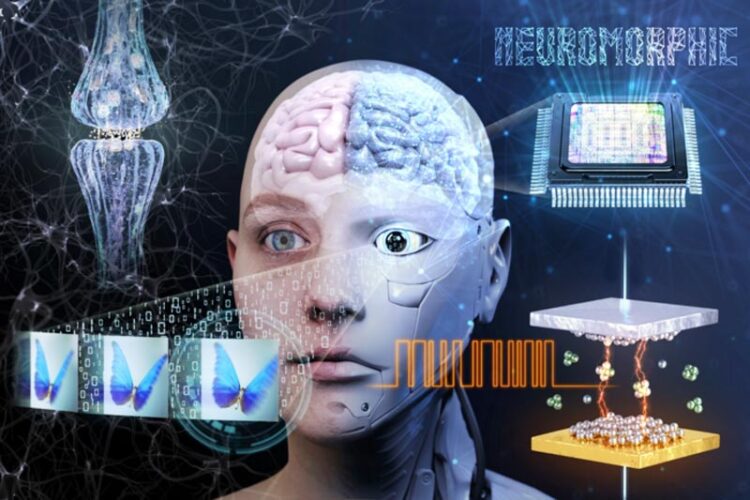High-performance and high-reliability artificial synaptic semiconductor device

Concept image of the article
Credit: Korea Institute of Science and Technology (KIST)
… regarding next-generation brain-mimicking computing.
KIST discovered critical variables to maximize the performance of artificial synaptic devices. Green light for next-generation neuromorphic system development.
Neuromorphic computing system technology mimicking the human brain has emerged and overcome the limitation of excessive power consumption regarding the existing von Neumann computing method. A high-performance, analog artificial synapse device, capable of expressing various synapse connection strengths, is required to implement a semiconductor device that uses a brain information transmission method. This method uses signals transmitted between neurons when a neuron generates a spike signal.
However, considering conventional resistance-variable memory devices widely used as artificial synapses, as the filament grows with varying resistance, the electric field increases, causing a feedback phenomenon, resulting in rapid filament growth. Therefore, it is challenging to implement considerable plasticity while maintaining analog (gradual) resistance variation concerning the filament type.
The Korea Institute of Science and Technology (KIST, President Yoon Seok-jin), led by Dr. YeonJoo Jeong’s team at the Center for Neuromorphic Engineering, solved the limitations of analog synaptic characteristics, plasticity and information preservation, which are chronic obstacles regarding memristors, neuromorphic semiconductor devices. He announced the development of an artificial synaptic semiconductor device capable of highly reliable neuromorphic computing.
The KIST research team fine-tuned the redox properties of active electrode ions to solve small synaptic plasticity hindering the performance of existing neuromorphic semiconductor devices. Furthermore, various transition metals were doped and used in the synaptic device, controlling the reduction probability of active electrode ions. It was discovered that the high reduction probability of ions is a critical variable in the development of high-performance artificial synaptic devices.
Therefore, a titanium transition metal, having a high ion reduction probability, was introduced by the research team into an existing artificial synaptic device. This maintains the synapse’s analog characteristics and the device plasticity at the synapse of the biological brain, approximately five times the difference between high and low resistances. Furthermore, they developed a high-performance neuromorphic semiconductor that is approximately 50 times more efficient.
Additionally, due to the high alloy formation reaction concerning the doped titanium transition metal, the information retention increased up to 63 times compared with the existing artificial synaptic device. Furthermore, brain functions, including long-term potentiation and long-term depression, could be more precisely simulated.
The team implemented an artificial neural network learning pattern using the developed artificial synaptic device and attempted artificial intelligence image recognition learning. As a result, the error rate was reduced by more than 60% compared with the existing artificial synaptic device; additionally, the handwriting image pattern (MNIST) recognition accuracy increased by more than 69%. The research team confirmed the feasibility of a high-performance neuromorphic computing system through this improved the artificial synaptic device.
Dr. Jeong of KIST stated, “This study drastically improved the synaptic range of motion and information preservation, which were the greatest technical barriers of existing synaptic mimics.” “In the developed artificial synapse device, the device’s analog operation area to express the synapse’s various connection strengths has been maximized, so the performance of brain simulation-based artificial intelligence computing will be improved.” Additionally, he mentioned, “In the follow-up research, we will manufacture a neuromorphic semiconductor chip based on the developed artificial synapse device to realize a high-performance artificial intelligence system, thereby further enhancing competitiveness in the domestic system and artificial intelligence semiconductor field.”
KIST was established in 1966 as the first government-funded research institute in Korea to establish a national development strategy based on science and technology and disseminate various industrial technologies to promote the development of major industries. KIST is now elevating the status of Korean science and technology through the pursuit of world-leading innovative research and development. For more information, please visit KIST’s website at https://eng.kist.re.kr/
This research was supported by the KIST institutional program and the Next-generation Intelligent Semiconductor Technology Project, funded by the Ministry of Science and ICT (Minister Jong-Ho Lee). The results have been published in the latest issue of “Nature Communications” (IF: 17.694).
Journal: Nature Communications
DOI: 10.1038/s41467-022-31804-4
Article Title: Cluster-type analogue memristor by engineering redox dynamics for high-performance neuromorphic computing
Article Publication Date: 20-Jul-2022
All latest news from the category: Information Technology
Here you can find a summary of innovations in the fields of information and data processing and up-to-date developments on IT equipment and hardware.
This area covers topics such as IT services, IT architectures, IT management and telecommunications.
Newest articles

Innovative 3D printed scaffolds offer new hope for bone healing
Researchers at the Institute for Bioengineering of Catalonia have developed novel 3D printed PLA-CaP scaffolds that promote blood vessel formation, ensuring better healing and regeneration of bone tissue. Bone is…

The surprising role of gut infection in Alzheimer’s disease
ASU- and Banner Alzheimer’s Institute-led study implicates link between a common virus and the disease, which travels from the gut to the brain and may be a target for antiviral…

Molecular gardening: New enzymes discovered for protein modification pruning
How deubiquitinases USP53 and USP54 cleave long polyubiquitin chains and how the former is linked to liver disease in children. Deubiquitinases (DUBs) are enzymes used by cells to trim protein…



